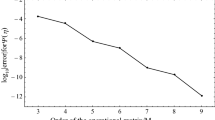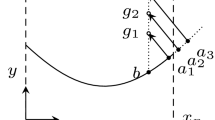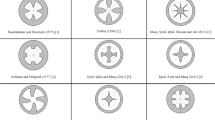Abstract
In this paper, we consider the inverse one-phase one-dimensional Stefan problem to study the thermal processes with phase change in a moving boundary problem and calculate the temperature distribution in the given domain, as well as approximate the temperature and the heat flux on a boundary of the region. For this problem, the location of the moving boundary and temperature distribution on this curve are available as the extra specifications. First, we use the Landau’s transformation to get a rectangular domain and then apply the Crank–Nicolson finite-difference scheme to discretize the time dimension and reduce the problem to a linear system of differential equations. Next, we employ the radial basis function collocation technique to approximate the spatial unknown function and its derivatives at each time level. Finally, the linear systems of algebraic equations constructed in this way are solved using the LU factorization method. To show the numerical convergence and stability of the proposed method, we solve two benchmark examples when the boundary data are exact or contaminated with additive noises.







Similar content being viewed by others
References
Abbasbandy S, Ghehsareh HR, Alhuthali MS, Alsulami HH (2014) Comparison of meshless local weak and strong forms based on particular solutions for a non-classical 2-D diffusion model. Eng Anal Bound Elem 39:121–128
Abbasbandy S, Shirzadi A (2011) MLPG method for two-dimensional diffusion equation with Neumann’s and non-classical boundary conditions. Appl Numer Math 61:170–180
Alexiades V, Solomon AD (1993) Mathematical modeling of melting and freezing processes. Hemisphere Publ. Corp, Washington
Assari P, Adibi H, Dehghan M (2013) A meshless method for solving nonlinear two-dimensional integral equations of the second kind on non-rectangular domains using radial basis functions with error analysis. J Comput Appl Math 239:72–92
Assari P, Adibi H, Dehghan M (2014) A meshless discrete galerkin (MDG) method for the numerical solution of integral equations with logarithmic kernels. J Comput Appl Math 267:160–181
Atkins DL, Ervin JS, Saxena A (2005) Computational model of the freezing of jet fuel. J Propul Power 21:356–367
Atluri SN, Zhu T (1998) A new meshless local Petrov–Galerkin (MLPG) approach in computational mechanics. Comput Mech 22:117–127
Barry SI, Caunce J (2008) Exact and numerical solutions to a Stefan problem with two moving boundaries. Appl Math Model 32:83–98
Beck JV, Blackwell B, Clair CRS (1985) Inverse heat conduction, Ill-posed problems. Wiley, New York
Cannon JR (1967) The Cauchy problem for the heat equation. SIAM J Numer Anal 4:17–36
Cannon JR (1984) The one-dimensional heat equation. Addison-Wesley, California
Cannon JR, Hill CD (1967) Existence, uniqueness, stability, and monotone dependence in a Stefan problem for the heat equation. SIAM J Numer Anal 17:1–19
Cannon JR, Primicerio M (1971) Remarks on the one-phase Stefan problem for the heat equation with the flux prescribed on the fixed boundary. J Math Anal Appl 35:361–373
Cannon JR, van der Hoek J (1982) The one phase Stefan problem subject to the specification of energy. J Math Anal Appl 86:281–291
Chang CL (2002) Pretreatment of wastewater by vacuum freezing system in a cool thermal storage process. J Sep Purif Technol 26:165–176
Dehghan M, Abbaszadeh M (2016) Numerical study of three-dimensional turing patterns using a meshless method based on moving Kriging element free Galerkin (EFG) approach. Comput Math Appl 72:427–454
Dehghan M, Abbaszadeh M (2017) Element free galerkin approach based on the reproducing kernel particle method for solving 2D fractional tricomi-type equation with Robin boundary condition. Comput Math Appl 73:1270–1285
Dehghan M, Ghesmati A (2010) The meshless local Petrov–Galerkin (MLPG) method: a simple and less-costly alternative to the finite element and boundary element methods. Eng Anal Bound Elem 34:324–336
Dehghan M, Mirzaei D (2008) The meshless local Petrov–Galerkin MLPG method for the generalized two-dimensional non-linear Schrodinger equation. Eng Anal Bound Elem 32:747–756
Dehghan M, Mirzaei D (2009) Meshless local boundary integral equation (LBIE) method for the unsteady magnetohydrodynamic (MHD) flow in rectangular and circular pipes. Comput Phys Commun 180:1458–1466
Dehghan M, Mirzaei D (2009) Meshless local Petrov–Galerkin (MLPG) method for the unsteady magnetohydrodynamic (MHD) flow through pipe with arbitrary wall conductivity. Appl Numer Math 59:1043–1058
Fasshauer G (2007) Meshfree approximation methods with MATLAB. Word Scientific Publishing, Singapore
Flannery BP, Press WH, Teukolsky SA, Vetterling WT (1996) Numerical recipes in Fortran 90: the art of parallel scientific computing. Cambridge University Press, New York
Griewank PJ, Notz D (2013) Insights into brine dynamics and sea ice desalination from a 1-d model study of gravity drainage. J Geophys Res Oceans 118:3370–3386
Grzymkowski R, Slota D (2006) One-phase inverse Stefan problem solved by Adomain decomposition method. Comput Math Appl 51:33–40
Hemami M, Parand K, Rad JA (2019) Numerical simulation of reaction–diffusion neural dynamics models and their synchronization/desynchronization: application to epileptic seizures. Comput Math Appl (2019) (in press)
Hetmaniok E, Slota D, Witula R, Zielonka A (2015) Solution of the one-phase inverse Stefan problem by using the homotopy analysis method. App Math Modell 39:6793–6805
Crank J (1996) Free and moving boundary problems. Clarendon Press, Oxford
Jochum P (1980) The numerical solution of the inverse Stefan problem. Numer Math 34:411–429
Johansson B, Lesnic D, Reeve T (2011) A method of fundamental solutions for the one-dimensional inverse Stefan problem. Appl Math Model 35:4367–4378
Johansson BT, Lesnic D, Reeve T (2011) A method of fundamental solutions for the one-dimensional inverse Stefan problem. Appl Math Model 35:4367–4378
Johansson BT, Lesnic D, Reeve T (2013) A meshless regularization method for a two-dimensional two-phase linear inverse Stefan problem. Adv Appl Math Mech 5(6):825–845
Kazem S, Rad JA, Parand K (2012) Radial basis functions methods for solving Fokker–Planck equation. Eng Anal Bound Elem 36:181–189
Lame G, Clapeyron BP (1831) Memoire sur la solidification par refroidissement d’un globe. Solide Ann Chem Phys 47:250–256
Larsson E, Shcherbakov V, Heryudono A (2017) A least squares radial basis function partition of unity method for solving PDEs. SIAM J Sci Comput 39:A2538–A2563
Lin H, Atluri SN (2000) Meshless local Petrov–Galerkin (MLPG) method for convection–diffusion problems. Comput Model Eng Sci 1:45–60
Liu CS (2011) Solving two typical inverse Stefan problems by using the Lie-group shooting method. Int J Heat Mass Transfer 54:1941–1949
Liu G (2009) Meshfree methods: moving beyond the finite element method. CRC Press, Boca Raton
Liu G, Gu Y (2005) An introduction to meshfree methods and their programing. Springer, Dordrecht
Loos F, Liess HT, Philippe B (2011) Transient analysis of the triggering behaviour of safety fuses. COMSOL Conference, Stuttgart, Germany
Murio DA (1992) Solution of inverse heat conduction problems with phase changes by the mollification method. Comput Math Appl 24:45–57
Needham DJ, Johansson B, Reeve T (2013) The development of a wax layer on the interior wall of a circular pipe transporting heated oil. Appl Math 67:93–125
Notz D, Worster MG (2009) Desalination processes of sea ice revisited. J Geophys Res 14:1–10
Ostrov DN, Goodman J (2002) On the early exercise boundary of the American put option. SIAM J Appl Math 62:1823–1835
Parand K, Rad JA (2012) Numerical solution of nonlinear Volterra–Fredholm–Hammerstein integral equations via collocation method based on radial basis functions. Appl Math Comput 218:5292–5309
Parand K, Rad JA (2012) Kansa method for the solution of a parabolic equation with an unknown spacewise-dependent coefficient subject to an extra measurement. Comput Phys Commun 184(2013):582–595
Quarteroni A, Sacco R, Saleri F (2000) Numerical mathematics. Springer, New York
Rad J, Parand K (2017) Pricing American options under jump-diffusion models using local weak form meshless techniques. I. J Comput Math 94:1694–1718
Rad J, Rashedi K, Parand K, Adib H (2017) The meshfree strong form methods for solving one dimensional inverse Cauchy–Stefan problem. Eng Comput 33:547–571
Rad JA, Hook J, Larsson E, Sydow L (2018) Forward deterministic pricing of options using Gaussian radial basis functions. J Comput Sci 24:209–217
Rad JA, Kazem S, Parand K (2012) A numerical solution of the nonlinear controlled Duffing oscillator by radial basis functions. Comput Math Appl 64:2049–2065
Rad JA, Parand K (2017) Numerical pricing of American options under two stochastic factor models with jumps using a meshless local Petrov–Galerkin method. Appl Numer Math 115:252–274
Rad JA, Parand K, Abbasbandy S (2015) Local weak form meshless techniques based on the radial point interpolation (RPI) method and local boundary integral equation (LBIE) method to evaluate European and American options. Commun Nonlinear Sci Numer Simul 22:1178–1200
Rad JA, Parand K, Ballestra LV (2015) Pricing European and American options by radial basis point interpolation. Appl Math Comput 251:363–377
Ramajayam KK, Kumar A (2013) A novel approach to improve the efficacy of tumour ablation during cryosurgery. Cryobiology 67:201–213
Rashedi K, Adibi H, Rad JA, Parand K (2014) Application of the meshfree methods for solving the inverse one-dimensional Stefan problem. Eng Anal Bound Elem 40:1–21
Reemtsen R, Kirsch A (1984) A method for the numerical solution of the one-dimensional inverse Stefan problem. Numer Math 45:253–273
Reeve TH (2013) The method of fundamental solutions for some direct and inverse problems. Ph. D. Dissertation, University of Birmingham
Rippa S (1999) An algorithm for selecting a good parameter \(c\) in radial basis function interpolation. Adv Comput Math 11:193–210
Rubinstein LI (1971) The Stefan problem. American Mathematical Society, Providence
Safdari-Vaighani A, Heryudono A, Larsson E (2015) A radial basis function partition of unity collocation method for convection–diffusion equations arising in financial applications. J Sci Comput 64:341–367
Safdari-Vaighani A, Larsson E, Heryudono A (2018) Radial basis function methods for the Rosenau equation and other higher order PDEs. J Sci Comput 75:1555–1580
Sarabadan S, Rashedi K, Adibi H (2017) Boundary determination of the inverse heat conduction problem in one and two dimensions via the collocation method based on the satisfier functions. Iran J Sci Technol Trans Sci. https://doi.org/10.1007/s40995-017-0240-y
Seblani YE, Shivanian E (2019) Boundary value identification of inverse Cauchy problems in arbitrary plane domain through meshless radial point hermite interpolation. Eng Comput (2019) (in press)
Shcherbakov V (2016) Radial basis function partition of unity operator splitting method for pricing multi-asset American options. BIT Numer Math 56:1401–1423
Shcherbakov V, Larsson E (2016) Radial basis function partition of unity methods for pricing vanilla basket options. Comput Math Appl 71:185–200
Shirzadi A, Ling L, Abbasbandy S (2012) Meshless simulations of the two-dimensional fractional-time convection–diffusion–reaction equations. Eng Anal Bound Elem 36:1522–1527
Singh S, Bhargava R (2014) Simulation of phase transition during cryosurgical treatment of a tumor tissue loaded with nanoparticles using meshfree approach. J Heat Transf 136:121101–121110
Slota D (2007) Direct and inverse one-phase Stefan problem solved by variational iteration method. Comput Math Appl 54:1139–1146
Slota D (2010) The application of the homotopy perturbation method to one-phase inverse Stefan problem. I. Commun Heat Mass Transf 37:587–592
Slota D, Zielonka A (2009) A new application of He’s variational iteration method for the solution of the one-phase Stefan problem. Comput Math Appl 58:2489–2494
Smith GD (1985) Numerical solution of partial differential equations: finite difference methods. Oxford University Press, New York
Stefan J (1889) Uber einige probleme der theorie der warmeletung. S B Wien Akad Mat Nat 98:473–484
Vrankar L, Kansa EJ, Ling L, Runovc F, Turk G (2010) Moving-boundary problems solved by adaptive radial basis functions. Comput Fluids 39:1480–1490
Vrankar L, Kansa EJ, Turk G, Runovc F (2006) Solving one-dimensional moving-boundary problems with meshless method. Math Ind 12:672–676
Vrankar L, Runovc F, Turk G (2007) The use of the mesh free methods (radial basis functions) in the modeling of radionuclide migration and moving boundary value problems. Acta Geotech Sloven 1:43–53
Wang J, Liu G (2002) A point interpolation meshless method based on radial basis functions. Int J Numer Methods Eng 54:1623–1648
Wendland H (2005) Scattered data approximation. Cambridge University Press, New York
Zerroukat M, Chatwin CR (1994) Computational moving boundary problems. Research Studies Press, Taunton
Author information
Authors and Affiliations
Corresponding author
Additional information
Publisher's Note
Springer Nature remains neutral with regard to jurisdictional claims in published maps and institutional affiliations.
Rights and permissions
About this article
Cite this article
Lotfi, Y., Parand, K., Rashedi, K. et al. Numerical study of temperature distribution in an inverse moving boundary problem using a meshless method. Engineering with Computers 37, 461–475 (2021). https://doi.org/10.1007/s00366-019-00835-9
Received:
Accepted:
Published:
Issue Date:
DOI: https://doi.org/10.1007/s00366-019-00835-9




